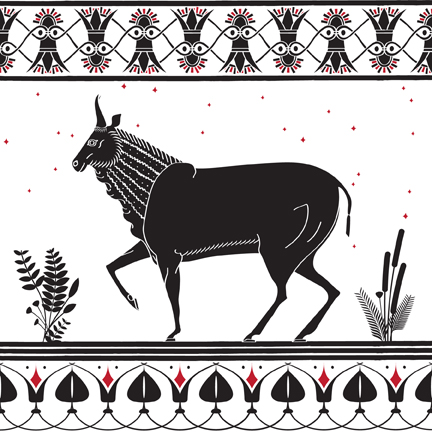The story of Io, ala Wikipedia, is fairly interesting:
According to Ovid, one day, Zeus noticed the maiden and lusted after her. As Io tells her own story in Aeschylus' Prometheus Bound, she rejected his whispered nighttime advances until the oracles caused her own father to drive her out into the fields of Lerna. There, Zeus covered her with clouds to hide her from the eyes of his jealous wife, Hera, who nonetheless came to investigate. In a vain attempt to hide his crimes, Zeus turned himself into a white cloud and transformed Io into a beautiful white heifer. Hera was not fooled. She demanded the heifer as a present.
Hera tethered Io to the olive-tree in the temenos of her cult-site, the Heraion, and placed her in the charge of many-eyed Argus Panoptes to keep her separated from Zeus. Zeus commanded Hermes to kill Argus; Ovid added the detail that he lulled all hundred eyes to sleep. Hera then forced Io to wander the earth without rest, plagued by a gadfly (Οίστρος or oestrus: see etymology of "estrus" ) to sting her into madness. Io eventually crossed the path between the Propontis and the Black Sea, which thus acquired the name Bosporus (meaning ox passage), where she met Prometheus.
Prometheus had been chained on Mt. Caucasus by Zeus for teaching mankind how to make fire and tricking him into accepting the worse part of a sacrifice while the mortals kept the better part (meat); every day, a gianteagle fed on Prometheus' liver. Despite his agony, he comforted Io with the information that she would be restored to human form and become the ancestress of the greatest of all heroes, Heracles (Hercules). Io escaped across the Ionian Sea to Egypt, where she was restored to human form by Zeus. There, she gave birth to Zeus's son Epaphus, and a daughter as well, Keroessa. She later married Egyptian king Telegonus. Their grandson, Danaos, eventually returned to Greece with his fifty daughters (the Danaids), as recalled inAeschylus' play The Suppliants.
I did this piece in record time. It took maybe 10 hours to design, draw, and finish everything.
This project is part of a more broad interest in Greek artwork, so my source image is, of course, from Greek pottery:
There were three things that I was interested in appropriating for this piece: the cow, the repeating floral designs, and the foliage. I think a lot of people underestimate the power of classical drawing. Simply because a thing is, well, simple does not mean that it is any less great. I think that Greek and Egyptian drawing is actually iconic rather than merely simple. Any art historian could point out baroque or rococo paintings, but pretty much any westerner could point out ancient art like this.
Anyway, the cow is great. This is my quick rendering on the cow on paper (always start on paper):
I worked out the remainder of the details in illustrator. As practice soon confirmed my intuitions, illustrator is not the ideal vehicle for the drawn aesthetic of Greek pottery. That said, illustrator made some things particularly easy.
I wanted to work with floral patterns, and I also wanted to learn how to use the software's brush options. For each pattern I designed (carefully, over many a guide line) only a single repeating section and then imported that into the "pattern brush" options. I had some problems with it, but it all worked out. Again, one thing that this misses, though, is the drawn-aesthetic. That is, all my floral designs look the same and are without human error or variation. That's something I'll look to fix in the next piece I do.
I tried to counteract the precision of illustrator with some sloppiness and the use of the 1pt oval brush on my pen strokes. That helped a little I think.
The final bit I focused on were those little bushes around Io. I followed this tutorial on art brush creation to good effect.
My final illustrator image was cool, but it didn't really capture Io in the way that I wanted it to. I felt I could fix this through colorization and texture, two things in which Greek pottery techniques exhibits limitations.
My idea was to bring the blues and greens of pastures, rivers, and the sadness of Io in her cow form, into the piece with Photoshop.
I found some textures on the great, free website CG Textures and manipulated them in photoshop. I took an image of water and brought out its blues, adding greens and gradients too. I added cracked plaster textures using the Darken blend mode to give the image deep colors and age.
Because I made this picture for a smaller print, I created a more-readable image without the textures too:





No comments:
Post a Comment